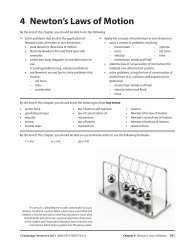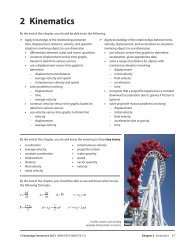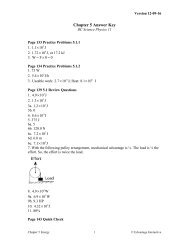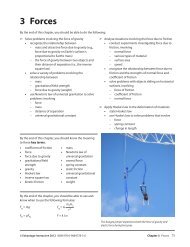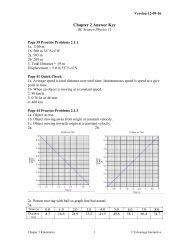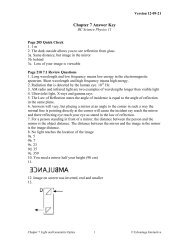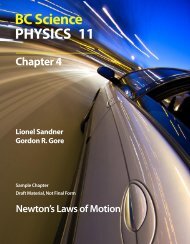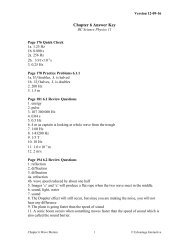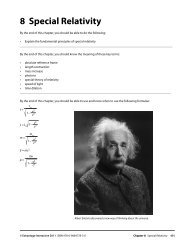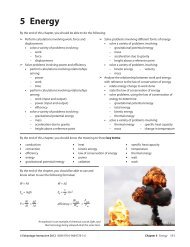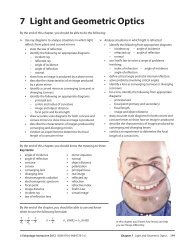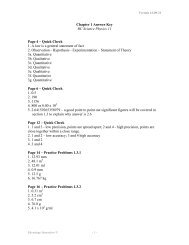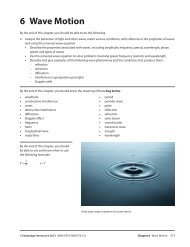1 Skills, Methods, and the Nature of Physics - BC Science Physics 11
1 Skills, Methods, and the Nature of Physics - BC Science Physics 11
1 Skills, Methods, and the Nature of Physics - BC Science Physics 11
You also want an ePaper? Increase the reach of your titles
YUMPU automatically turns print PDFs into web optimized ePapers that Google loves.
1.2 Equipment Essentials<br />
Warm Up<br />
Your teacher will give you a pendulum made from some string <strong>and</strong> a washer. One swing <strong>of</strong> <strong>the</strong> pendulum back<br />
<strong>and</strong> forth is called a period <strong>and</strong> measured in seconds. Work with a partner to determine <strong>the</strong> period <strong>of</strong> your<br />
pendulum. Outline your procedure <strong>and</strong> results below. When you are done, identify one thing you would change<br />
in your procedure to improve your answer.<br />
Using a Calculator<br />
Quick Check<br />
A calculator is a tool that helps you perform calculations during investigations <strong>and</strong><br />
solving problems. You’ll have your calculator with you for every class. At <strong>the</strong> same time,<br />
however, you are not to rely on it exclusively. You need to underst<strong>and</strong> what <strong>the</strong> question<br />
is asking <strong>and</strong> what formula or calculation you need to use before you use your calculator.<br />
If you find yourself just pushing buttons to find an answer without underst<strong>and</strong>ing <strong>the</strong><br />
question, you need to talk to your teacher or a classmate to figure it out. Many times<br />
you’ll just need one concept clarified <strong>and</strong> <strong>the</strong>n you can solve <strong>the</strong> problem.<br />
Every calculator is different in terms <strong>of</strong> what order <strong>of</strong> buttons you need to push<br />
to find your answer. Use <strong>the</strong> Quick Check below to ensure you can find trigonometric<br />
functions <strong>and</strong> enter <strong>and</strong> manipulate exponents. If you cannot find <strong>the</strong> answers for <strong>the</strong>se<br />
questions, check with your teacher immediately.<br />
Using your calculator, what are <strong>the</strong> answers to <strong>the</strong> following ma<strong>the</strong>matical statements?<br />
1. sin 30° ________________________________ 4. (3.2 × 10 –4 ) × (2.5 × 10 6 )___________________________<br />
2. tan –1 .345 _____________________________ 5. pi – cos 60°_____________________________________<br />
3. 34 2 ___________________________________<br />
Measuring Time<br />
For objects that have a regularly repeated motion, each complete movement is called a<br />
cycle. The time during which <strong>the</strong> cycle is completed is called <strong>the</strong> period <strong>of</strong> <strong>the</strong> cycle. The<br />
number <strong>of</strong> cycles completed in one unit <strong>of</strong> time is called <strong>the</strong> frequency (ƒ) <strong>of</strong> <strong>the</strong> moving<br />
object. You may be familiar with <strong>the</strong> frequencies <strong>of</strong> several everyday objects. For example,<br />
a car engine may have a frequency <strong>of</strong> several thous<strong>and</strong> rpm (revolutions per minute).<br />
6 Chapter 1 <strong>Skills</strong>, <strong>Methods</strong>, <strong>and</strong> <strong>the</strong> <strong>Nature</strong> <strong>of</strong> <strong>Physics</strong> © Edvantage Interactive 2012 ISBN 978-0-9864778-3-6



